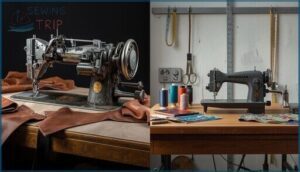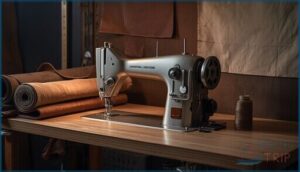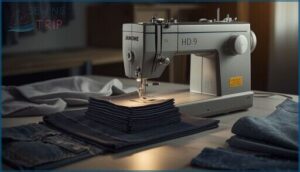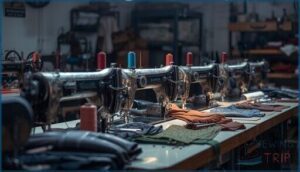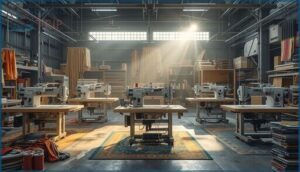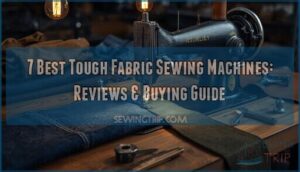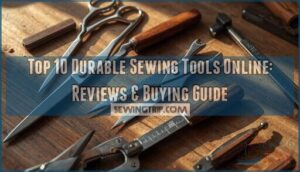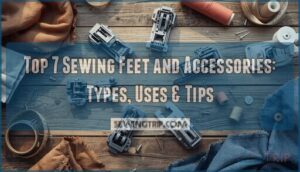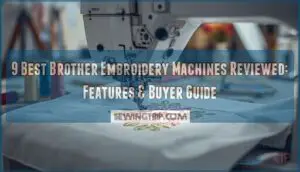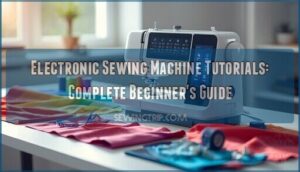This site is supported by our readers. We may earn a commission, at no cost to you, if you purchase through links.
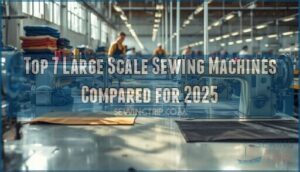
Your machine choice determines whether you’re wrestling with breakdowns every month or running nonstop shifts with nothing more than routine maintenance. The gap between heavy-duty domestic models and true industrial workhorses isn’t just about size—it’s about whether your equipment matches your ambition.
Seven machines stand out in 2025 for businesses ready to scale up their sewing operations.
Table Of Contents
Key Takeaways
- Industrial machines deliver 400-850 watts of motor power compared to just 50-100 watts in domestic models, enabling them to punch through eight layers of leather and run continuously for 20+ years in production environments.
- The gap between semi-professional hybrids ($800-$2,500) and full industrial setups ($2,000-$5,000+) comes down to workspace requirements and production volume—if you’re sewing 40+ hours weekly with thick materials, industrial isn’t optional.
- Speed separates hobbyist work from commercial output: industrial machines hit 3,000-5,000 stitches per minute while domestic models max out around 800, with top performers like the Janome HD9 reaching 1,600 SPM in a compact footprint.
- Smart features like jumbo bobbins (40% more thread capacity), automatic thread cutters, and servo motors cut downtime by up to 90% on high-volume runs, directly translating wasted minutes into finished products.
Industrial Vs. Heavy Duty Sewing Machines
Choosing between industrial and heavy-duty sewing machines can feel like exploring a maze of specs and price tags. The truth is, your decision hinges on three things: how much you’ll sew, what materials you’ll tackle, and whether you need portability or pure power.
Let’s break down the key differences so you can match the right machine to your workflow.
Key Differences Between Industrial and Domestic Machines
When comparing industrial sewing machines to domestic heavy-duty models, motor wattage is a defining factor. Industrial machines boast 400 to 850 watts, while domestic ones operate on just 50 to 100 watts. This power disparity directly impacts material handling—industrial machines effortlessly cut through multilayered leather and canvas. A notable feature of industrial machines is their automatic thread cutting capability, enhancing efficiency.
| Feature | Industrial Heavy-Duty Machines | Domestic Heavy-Duty Sewing Machine |
|---|---|---|
| Motor Wattage | 400–850 watts | 50–100 watts |
| Lifespan Expectancy | 20+ years (continuous use) | 5–10 years (moderate use) |
| Stitch Specialization | Single-function (straight, overlock, zigzag) | 20+ built-in patterns |
Industrial machines excel in stitch specialization, performing a single task flawlessly at speeds of 3,000 to 5,000 stitches per minute. In contrast, domestic machines offer versatility with over 20 built-in patterns but max out at around 800 stitches per minute. Cost-wise, industrial machines start at $1,000 and can exceed $5,000, whereas domestic models range from $300 to $1,000.
The comparison highlights clear distinctions: industrial machines are built for longevity, lasting over 20 years under factory conditions, while domestic units cater to hobbyists with a lifespan of 5 to 10 years. These features determine whether a machine is suited for a production floor or a home studio.
When to Choose Industrial Over Domestic
If you’re stitching more than ten hours a week or working with materials thicker than two layers of denim, an industrial machine isn’t just an upgrade—it’s a necessity. Production volume matters most—commercial sewing machines manage continuous operation without overheating. Project complexity requiring specialized stitches (like overlock or zigzag) demands industrial precision.
| Decision Factor | Choose Industrial When… |
|---|---|
| Fabric Types | Leather, canvas, or multilayer upholstery |
| Production Volume | 40+ hours weekly or batch runs |
| Space Requirements | You’ve got dedicated workspace (200+ sq ft) |
Budget impact runs $2,000–$5,000 for industrial sewing machines versus $300–$1,000 for heavy-duty sewing machines, but longevity justifies the cost.
Semi-Professional Options Explained
Semi-professional machines give you industrial muscle without sacrificing your spare bedroom or draining your bank account. These hybrid powerhouses bridge the gap between home and factory—think 0.7-1.4 amp motors managing leather or canvas while fitting on a standard table.
| Feature | Semi-Professional | Full Industrial |
|---|---|---|
| Motor Power | 0.7–1.4 amps | 2+ amps |
| Workspace Needed | 50–100 sq ft | 200+ sq ft |
| Price Range | $800–$2,500 | $2,000–$5,000+ |
You’ll sacrifice some stitch variety and maintenance intervals compared to heavy-duty sewing machines, but material control rivals true industrial models.
The Janome HD9—Professional Power, Compact Size
The Janome HD9 proves you don’t need a factory floor to punch through twelve layers of denim—just 18 inches of desk space and a machine that’s built like a tank. Its separate heavy-weight thread guide and extra presser foot lift accommodate everything from silk to canvas, while the bobbin system keeps high-speed runs stitch-precise.
Professional sewing machines don’t get more adaptable—this compact powerhouse transforms fabric treatment across your entire workflow.
| HD9 Features | Advantage |
|---|---|
| Thread Guide | Works with heavy-weight thread without snags |
| Presser Foot Lift | Extra clearance for thick fabric layers |
| Project Adaptability | Works with delicate to heavyweight materials |
Essential Features for Large Scale Sewing
When you’re shopping for a large-scale sewing machine, you need to know what separates a powerhouse from a paperweight. The right features turn marathon projects into smooth operations, whether you’re stitching leather, quilting king-size blankets, or running a small upholstery business.
Let’s break down the five must-have features that’ll keep your machine running strong when the workload gets heavy.
Motor Power and Stitching Speed
You won’t get far sewing thick leather or heavy denim if your motor can’t push the needle through. Industrial sewing machines pack motors from 400 to 750 watts—up to five times stronger than domestic units—and hit stitching speeds of 4,000 to 6,000 rpm.
Servo motors with agile torque management deliver precise speed control and use 80% less power than clutch motors, while direct-drive systems boost efficiency.
High-speed commercial sewing machines process material effortlessly, and modern power trends point toward AI-enhanced motor efficiency for demanding production runs. The growth of the market is expected to continue, reaching USD 6043.75 Million by 2034.
Durability and Frame Construction
Power means nothing if your frame buckles under years of constant stitching. Heavy-duty sewing machines with an all-metal frame outlast plastic housings by decades, delivering rock-solid sewing machine durability.
Quality components reduce vibration dampening issues and keep tolerances tight. Maintenance needs stay predictable—lubricate, adjust tension, replace wear parts—while lifespan expectancy stretches beyond 20 years.
A durable frame transforms your investment into a workhorse that won’t quit.
Versatility for Various Fabrics
From delicate silk scarves to heavyweight canvas totes, your machine needs to shift gears without breaking a sweat. Fabric weight demands quick stitch adjustments—longer lengths for thick fabrics like leather and denim, finer settings for chiffon.
Needle selection and thread compatibility work hand in hand, while swapping presser feet unlocks true sewing machine adaptability across every fabric type you throw at it.
Time-Saving Built-in Features
Built-in needle threaders and drop-in bobbins don’t just speed things up—they can shave hours off your weekly sewing time and keep you focused on the fabric, not the fuss. Here’s what transforms workflow efficiency:
- Needle threaders eliminate eye strain and fumbling—thread fast, every single time
- Drop-in bobbins let you swap thread colors in seconds without wrestling tension springs
- Automatic cutting trims threads cleanly so you don’t reach for scissors constantly
- Programmable stitches store your favorite settings for instant recall on repeat projects
- Speed control lets you throttle power precisely—critical for thick seams or delicate corners
Customizable Stitch Options
When you’re stitching everything from whisper-thin silk to heavyweight canvas in a single week, locking in the right stitch width, length, and pattern can mean the difference between a perfect finish and starting over.
Look for machines that let you dial in stitch precision—adjustable zigzag stitch width, straight stitch length, and memory settings that store your go-to decorative stitches. That adaptability unlocks pattern creation without swapping machines mid-project.
Top 7 Large Scale Sewing Machines Compared
You’ve narrowed down your needs, and now it’s time to see what’s actually out there. We’ve compared seven machines that can manage serious workloads without breaking a sweat.
Here’s how they stack up for power, durability, and value.
1. Janome HD9 Heavy Duty Sewing Machine
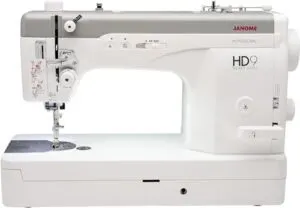
You need a machine that won’t slow you down when demand peaks—that’s where the Janome HD9 Heavy Duty Sewing Machine proves its worth. This sewing machine hits 1,600 stitches per minute, making it the fastest home-use straight-stitch option for thick fabrics like leather and denim.
Its industrial HLx5 needle system punches through multiple layers without hesitation, while the heavy weight thread guide keeps tension steady on heavyweight threads. The jumbo bobbin system holds 40% more thread than standard models, so you spend less time reloading.
You’ll also get adjustable presser feet, speed control, and a knee lifter—features usually reserved for full-scale industrial setups.
Best For: Professional sewists, quilters, and small business owners who need industrial-level speed and durability for high-volume projects with heavy fabrics like leather, denim, and canvas.
- Blazing fast at 1,600 stitches per minute with a jumbo bobbin that holds 40% more thread, drastically cutting downtime on large projects
- Built tough with cast aluminum frame, industrial needle system, and 11 lbs of presser foot pressure to power through thick layers without stalling
- Smart features like automatic thread cutter, independent bobbin winder, knee lifter, and adjustable speed control streamline your workflow
- At $1,999, it’s a serious investment that might be overkill for casual hobbyists or occasional sewers
- Straight-stitch only—no zigzag or decorative stitches, so you’ll need another machine for variety work
- No clear warranty or support details provided, and heavy-duty setup may need fine-tuning for optimal performance
2. Janome HD3000 Heavy Duty Machine
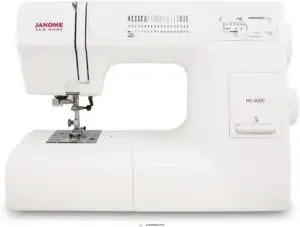
If you need something slightly more budget-friendly without sacrificing HD3000 Durability, the Janome HD3000 delivers solid performance. This machine tackles thick fabrics with its aluminum frame and 7-piece feed dog system, pushing through up to eight layers of denim at 860 stitches per minute.
You get 18 stitches, manual tension control, and six snap-on presser feet—perfect for garment alterations and home décor projects. The built-in needle threader and drop feed lever add user-friendliness, while the lifetime service plan backs your investment.
At around $527, it’s a reliable Heavy Duty sewing machine for professionals who value stitch capabilities and market value over maximum speed.
Best For: Sewers who need a workhorse machine for heavy fabrics like denim and upholstery without breaking the bank, especially those doing garment alterations and home décor projects.
- Handles thick materials effortlessly—sews through up to 8 layers of denim at 860 stitches per minute with a sturdy aluminum frame and 7-piece feed dog system
- Comes with lifetime nationwide service plan and proven durability, with users reporting nearly a decade of reliable use with minimal repairs
- Includes 6 snap-on presser feet, built-in needle threader, and manual controls that give you precise control without complicated computerized features
- Limited to 18 stitches with a three-step buttonhole process, which feels less convenient compared to one-step buttonhole machines
- Small harp space and lack of walking foot or specialized quilting features make it less suitable for large quilting projects
- At $527, it’s pricier than the $400-500 market range mentioned in reviews, though still reasonable for its heavy-duty capabilities
3. SINGER 4423 Heavy Duty Sewing Machine
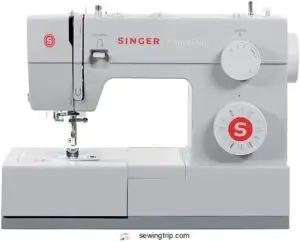
The Singer 4423 cranks up Motor Power with a 60% boost over standard machines, punching through leather and canvas at 1,100 stitches per minute—30% faster than typical domestic units.
You’ll discover 23 Stitch Variety options, including stretch and decorative patterns, plus adjustable width and length for precision topstitching.
User Convenience shines through the automatic needle threader, drop-in bobbin, and LED work light, while Fabric Control stays consistent thanks to adjustable presser foot pressure and a stainless steel bedplate.
Recognized as a Which? Best Buy winner and priced around $250, this Heavy Duty sewing machine delivers superb Market Value for small businesses and serious hobbyists chasing professional results without breaking the bank.
Best For: Sewers who need speed and power for heavy fabrics like denim or canvas, whether you’re a beginner tackling your first quilt or an experienced maker running a small business.
- Rips through thick materials at 1,100 stitches per minute with 60% more motor power than standard machines, saving hours on large projects
- Automatic needle threader and drop-in bobbin make setup painless, while the LED light and free arm handle detail work beautifully
- Which? Best Buy winner at $250 delivers professional-grade construction and speed without the premium price tag
- Manual clarity disappoints some users, leaving you hunting online for threading tips or troubleshooting guidance
- Noisy operation and touchy foot control take practice to master, especially if you’re used to quieter machines
- Quality control issues pop up occasionally—some buyers report defective units or tension adjustment headaches right out of the box
4. Elna 3210 Jeans Sewing Machine
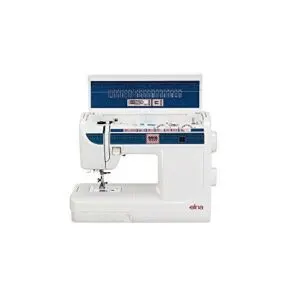
The Elna 3210 Easy Jeans tears through eight layers of denim without a hiccup, making denim sewing a breeze when you’re hemming heavyweight jeans or stitching canvas bags. At $499, you’ll gain 19 stitches, adjustable presser foot pressure, and a reinforced needle bar that guarantees stitch quality on leather and upholstery.
User experience stays smooth thanks to the built-in threader and clip-on feet—perfect for fast project changes.
Machine durability shines through its heavy-duty frame and horizontal rotary hook, while pricing support includes lifetime service at authorized dealers and compatibility with Janome parts.
Best For: Sewists who regularly work with heavy fabrics like denim, canvas, and leather and need a reliable machine that handles multiple layers without jamming.
- Powers through up to eight layers of denim with a reinforced needle bar and strong motor that maintains consistent stitch quality on thick materials
- Includes 19 built-in stitches with a one-step buttonhole, built-in threader, and clip-on presser feet for quick project transitions
- Comes with lifetime support at authorized dealers and compatibility with Janome parts for long-term reliability
- Some users reported machine breakdowns after short-term use, raising durability concerns
- Warranty repairs require shipping back to the original dealer, which can be time-consuming and inconvenient for online purchases
- Limited control over the repair process since only authorized dealers can perform warranty work
5. Juki TL 2010Q Sewing Quilting Machine
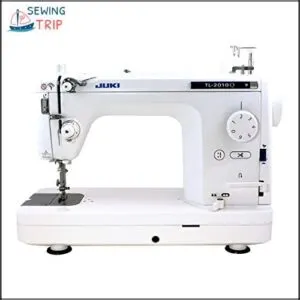
The Juki TL2010Q runs up to 1,500 stitches per minute—a real advantage for quilting large projects or piecing tops fast. You’ll get a dedicated straight stitch lockstitch head, knee-lift operation, and an automatic thread cutter that saves seconds on every seam.
At $1,199, this machine delivers industrial-grade precision in a compact 25″ footprint, ideal for free-motion quilting and heavy-duty sewing.
Threading issues can slow you down initially, and daily oil maintenance keeps the rotary hook smooth. Specialty presser feet aren’t universal, so budget for Juki-compatible accessories to fully realize its potential.
Best For: Quilters and serious sewers who need industrial speed and precision for large projects and are comfortable with daily maintenance routines.
- Blazing fast 1,500 stitches per minute with excellent stitch consistency for quick project completion
- Knee lift and auto thread cutter keep your hands free for smooth fabric guidance
- Heavy-duty construction handles thick layers and large quilts without struggle
- Straight stitch only—no zigzag or decorative stitches available
- Daily oiling is required and can be messy, plus threading takes practice
- Specialized presser feet cost extra and aren’t compatible with standard machines
6. JUKI Haruka TL18QVP Sewing Machine
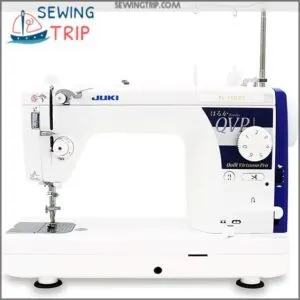
The JUKI Haruka TL-18QVP powers through thick seams at speeds up to 1,500 stitches per minute—matching the Juki TL2010Q for high-speed straight stitch precision. You’ll appreciate the floating presser foot that glides over bulky layers and the knee-controlled lifter for hands-free fabric positioning during quilting projects and free-motion embroidery.
At $1,899, it’s pricier but offers attachment compatibility with a dedicated mounting plate. However, user comfort issues arise: no zigzag capability, a finicky automatic threader, and small Class 15 bobbins that limit continuous sewing.
In any sewing machine comparison, weigh these sewing machine features against your workflow demands.
Best For: Quilters and sewers who need industrial-speed straight stitching for thick fabrics and free-motion work, and don’t mind investing in a specialized machine.
- Industrial-grade performance with speeds up to 1,500 SPM and a floating presser foot that handles thick seams and bulky layers effortlessly.
- Knee-controlled foot lifter and automatic thread cutter keep your hands free for precise fabric control during quilting and free-motion embroidery.
- Dedicated attachment mounting plate expands functionality with compatible accessories like walking feet and quilting guides.
- Straight stitch only—no zigzag or decorative stitches, limiting versatility for varied sewing projects.
- Comfort issues include a difficult automatic needle threader, small Class 15 bobbins requiring frequent refills, and an expensive-to-replace foot pedal.
- Fabric feeding can be inconsistent for garment sewing, often requiring a walking foot, and the service manual lacks helpful detail.
7. CKPSMS Jumbo Bobbins Janome HD9
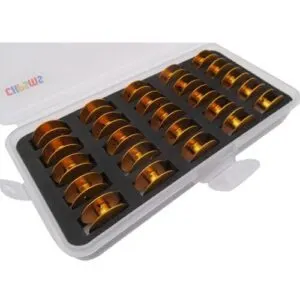
CKPSMS jumbo metal bobbins for the Janome HD9 Version 2 pack 40% more thread than standard L-sized bobbins—cutting bobbin-change interruptions by up to 90% during high-volume runs. You’ll see measurable productivity gains on quilting and embroidery projects, where every minute counts.
At roughly 35% less than original Janome parts, these aluminum bobbins deliver cost savings without sacrificing durability testing standards or stitch quality. Verify your HD9 is Version 2 (full-circle bobbin case) before ordering; Version 1 uses a different design.
For sewing machine comparison shoppers seeking heavy-duty sewing machine reviews, bobbin compatibility and thread capacity remain critical workflow factors.
Best For: Professional sewers, quilters, and embroiderers with Janome HD9 Version 2 or HD9BE machines who run long projects and want to minimize thread-change interruptions.
- Holds 40% more thread than standard L-sized bobbins, reducing bobbin changes by up to 90% during high-volume sewing sessions
- Priced approximately 35% lower than original Janome bobbins while maintaining equivalent stitch quality and durability
- Durable aluminum construction resists deformation at speeds up to 1,600 stitches per minute
- Only compatible with HD9 Version 2 and HD9BE (not Version 1), requiring careful verification before purchase
- Limited cross-brand compatibility compared to standard bobbin sizes used across multiple machine types
- Higher upfront investment per bobbin compared to standard plastic bobbins, though offset by reduced replacement frequency
Choosing The Right Machine for Your Business
Choosing the right machine isn’t just about power—it’s about matching your tools to your real-world workflow. You need to weigh what you’re sewing, how much space you’ve got, and where your business is headed.
Let’s break down the four key factors that’ll guide you to the perfect fit.
Assessing Your Commercial Sewing Needs
Before you invest thousands in the wrong equipment, you need to nail down exactly what kind of work your operation will process day in and day out. Are you sewing fifty garments weekly or five hundred? Will you tackle leather upholstery, denim alterations, or delicate silks?
Your project volume and fabric types determine whether you need industrial-grade power or if commercial sewing machines suffice. Factor in your budget constraints, available floor space, and your team’s skill level—these realities shape your entire setup.
Matching Machine Features to Project Types
Once you know your workload, you can match specific machine features to the fabrics and seams you’ll work with most often. Heavy-duty sewing machines with higher motor power and stitch precision cut through thick materials, while commercial sewing machines offer adaptability for mixed projects:
- Leather upholstery demands walking-foot mechanisms and 1.4+ amp motors
- Denim alterations require adjustable presser-foot pressure and strong needle penetration
- Quilting projects benefit from extended throat space and faster stitching speeds
- Delicate silks need computerized stitch options and precise tension control
Match sewing machine features to your project complexity and skill level—that’s how you get the most out of fabric compatibility without overspending on industrial sewing machines you won’t fully use.
Budget, Space, and Scalability Considerations
Your initial investment shapes everything—from motor power to scalability planning. Home heavy-duty machines start around $400, semi-professional models run $1,500–$2,500, while industrial sewing machine brands like Juki command $2,000–$4,750 depending on commercial sewing applications.
Factor in operating costs (maintenance, electricity), space requirements for industrial operations, and workflow design that fosters growth.
Smart ROI analysis compares upfront price against throughput gains, helping you avoid undersized equipment when commercial sewing machine sales volume climbs.
Where to Buy and Customer Support Tips
The dealer you pick can be the difference between smooth sailing and a maintenance nightmare. Prioritize these when comparing industrial sewing machine suppliers:
- Authorized dealers offering genuine sewing machine parts
- Warranty support with local repair services
- Online retailers stocking sewing machine accessories
- Customer support response times under 24 hours
- User communities sharing troubleshooting tips
Strong sewing machine brands back their equipment—don’t settle for less.
Industrial Sewing Machine Applications and Trends
Industrial sewing machines aren’t just about power—they’re built to take on specific jobs that home machines can’t manage. From stitching through thick leather to finishing carpet edges, the right machine transforms what’s possible in your shop.
Let’s look at the applications driving today’s market and what’s coming next.
Heavy-Duty Projects: Jeans, Leather, Upholstery
When you’re punching through layers of denim, wrestling with leather hides, or upholstering furniture that needs to last decades, your machine becomes more than a tool—it’s your business partner. Heavy-duty sewing machines built for denim sewing and leather crafting deliver the motor power and seam strength you need. Upholstery repair demands consistent penetration through heavy fabrics without stalling.
| Project Type | Machine Requirements |
|---|---|
| Denim Sewing | High-speed motor, reinforced needle system |
| Leather Crafting | Walking foot, adjustable presser foot pressure |
| Upholstery Repair | Extended throat space, thick thread capacity |
| Multi-Layer Seams | 60% more piercing power, metal frame |
| Canvas & Webbing | Variable speed control, heavy-duty feed dogs |
Specialized Machines: Overlock, Zigzag, Carpet Binders
Beyond basic stitching, specialized industrial machines—overlock, zigzag, and carpet binders—turn edge finishing, decorative work, and carpet installation into fast, repeatable operations. Industrial overlock machines employ overlock stitch types for seam sealing. Industrial zig zag units deliver zigzag stitch uses like reinforcement and decorative edges. Industrial carpet binders apply carpet binding methods that lock edges permanently.
These specialty machines excel at specialized material movement in commercial sewing, but maintenance best practices—regular lubrication and tension checks—keep them running without downtime.
Market Growth, Automation, and Regional Insights
Your specialty machines solve problems, but global textile industry momentum fuels demand for every commercial sewing tool. The market CAGR sits at 5.92% through 2030, while U.S. consumption jumped 21% in 2024 to 435,000 units.
Automation impact reshapes garment production—IoT-enabled industrial sewing machines cut downtime, and smart manufacturing feeds regional consumption in Asia Pacific, which holds 41.7% market share.
E-commerce effects push upholstery and apparel shops toward faster, connected equipment.
Future Trends: Computerized and AI-Powered Machines
Computerized precision and AI integration power tomorrow’s industrial sewing machines. Smart sensors deliver predictive maintenance—catching worn parts before breakdowns halt production. You’ll see:
- Automated stitching that adjusts tension and speed by fabric type
- Digital customization storing 500+ stitch patterns instantly
- IoT dashboards tracking uptime across your entire sewing equipment fleet
Computerized industrial sewing machines lead the highest CAGR through 2030, automating what once demanded constant operator adjustment.
Frequently Asked Questions (FAQs)
What maintenance schedule do large scale machines require?
Your heavy-duty machine needs love to last. Oiling frequency depends on usage—industrial sewing machines require daily automatic lubrication or manual oiling.
Schedule belt replacement annually, motor servicing every six months, and tension adjustments monthly.
Maintain a weekly cleaning schedule for peak performance.
How much workspace is needed for industrial models?
Industrial equipment demands serious real estate. Your machine footprint commonly needs 6-8 feet of workspace dimensions with extra room for ergonomic layout and storage solutions.
Proper sewing machine workflow and expansion planning guarantee commercial sewing efficiency.
What warranty coverage comes with commercial sewing machines?
Manufacturers commonly offer one to five years of warranty length on professional sewing machines, covering parts but not labor costs. Exclusions details often leave out normal wear items and damage from continuous use.
The claim process requires proof of purchase and authorized service centers for commercial needs.
Are replacement parts readily available for these machines?
Major brands like Janome, Singer, and Juki maintain extensive parts websites, ensuring replacement parts stay readily available. Brand reliability directly impacts repair costs and downtime reduction.
Industrial sewing machines from established manufacturers offer better part sourcing, extending lifespan and simplifying sewing machine repair.
Conclusion
Picture a production floor humming with uninterrupted rhythm—spools spinning, needles piercing denim stacks, orders shipping on time. That’s the difference between guessing and investing in proven large-scale sewing machines.
The seven models here deliver motor power, frame durability, and stitch precision that turn ambitious projects into reliable income. Your choice isn’t just equipment—it’s the foundation for every deadline you’ll meet, every client you’ll impress, and every expansion you’ll confidently plan.
Match your workload to the right machine, and you’re not buying metal and thread—you’re building capacity that compounds.
- https://www.grandviewresearch.com/industry-analysis/sewing-machine-market-report
- https://www.gminsights.com/industry-analysis/industrial-sewing-machine-market
- https://www.verifiedmarketreports.com/product/full-automatic-industrial-sewing-machines-market/
- https://www.linkedin.com/pulse/unraveling-precision-role-industrial-sewing-machines-modern-arora-yehec
- https://apparelresources.com/technology-news/manufacturing-tech/machine-makers-bet-big-innovation-bharat-story/


